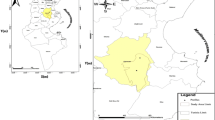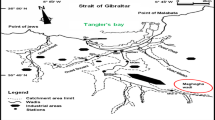Abstract
Coupling surface water and groundwater models dynamically based on a simultaneous simulation of saturated and unsaturated zones of soil is a useful method for determining the recharge rate and flow exchange between a river and an aquifer as well as simultaneous operation of water resources systems. Thus, the main objectives of this study are to investigate the effects of surface water and groundwater interactions through their systematic simulation and to create a dynamic coupling between surface water and groundwater resources of the area by relevant mathematical models. Accordingly, hydrologic soil moisture method and MODFLOW model were employed to simulate the unsaturated and saturated zones, respectively. The results revealed that simultaneous simulation of the saturated and unsaturated zones of the soil can illustrate the interaction between surface water and groundwater at any spatial and temporal intervals well through using complete hydroclimatological balance components in the form of a coupled model. The application of this method in the Loor-Andimeshk Plain, located in the southwest of Iran, showed that aquifer recharge through the plain area from November to March is due to precipitation. On the other hand, in the warm months (June to September), the plain is merely fed through irrigation water penetration. As the level of river water in both Dez and Balarood rivers is higher than the Loor-Andimeshk aquifer level, hence the exchange occurs as a leakage from the river to the aquifer. The highest and lowest values of average exchangeable water in Balarood River occur in March and April and in Dez River are from June to September.










Similar content being viewed by others
References
Aguilar JB, Xie Y, Cook PG (2015) Importance of stream infiltration data for modelling surface water–groundwater interactions. J Hydrol 528:683–693. https://doi.org/10.1016/j.jhydrol.2015.07.012
Bear J (2010) Modeling groundwater flow and contaminant transport. Springer Verlag, vol23, 834 P
Brenot A, Petelet-Giraud E, Gourcy L (2015) Insight from surface water-groundwater interactions in an alluvial aquifer: contributions of δ2H and δ18O of water, δ34SSO4 and δ18OSO4 of sulfates, 87Sr/86Sr ratio. Procedia Earth Planet Sci 13:84–87. https://doi.org/10.1016/j.proeps.2015.07.020
Christelis V, Mantoglou A (2018) Pumping optimization of coastal aquifers using seawater intrusion models of variable-Fidelity and evolutionary algorithms. Water Resour Manag 33:555–568. https://doi.org/10.1007/s11269-018-2116-0
Doppler T, Franssen HJH, Kaiser HP, Kuhlman U, Stauffer F (2007) Field evidence of a dynamic leakage coefficient for modelling river-aquifer interactions. J Hydrol 347(1–2):177–187. https://doi.org/10.1016/j.jhydrot.2007.09.017
Eastoe CHJ, Hutchison WR, Hibbs BJ, Hawley J, Hogan JF (2010) Interaction of a river with an alluvial basin aquifer: stable isotopes, salinity and water budgets. J Hydrol 395(2010):67–78
Engeler I, Hendricks Franssen HJ, Müller R, Stauffe F (2011) The importance of coupled modelling of variably saturated groundwater flow-heat transport for assessing river–aquifer interactions. J Hydrol 397:295–305
Fleckenstein JH, Krause S, Hannah DM, Boano F (2010) Groundwater-surface water interactions-new methods and models to improve understanding of processes and dynamics. J Adv Water Resour 33:1291–1295
Gorelick SM (1983) A review of distributed parameter groundwater management modelling methods. Water Resour Res 19(2):305–319
Graham PW, Andersen MS, McCabe MF, Ajami H, Baker A, Acworth I (2015) To what extent do long-duration high-volume dam releases influence river–aquifer interactions? A case study in New South Wales, Australia. Hydrogeol J 23:319–334
Hadded R, Nouiri I, Alshihabi Q, Mabmann J, Huber M, Laghouane A, Yahiaoui H, Tarhouni J (2013) A decision support system to manage the groundwater of the Zeuss Koutine aquifer using the WEAP-MODFLOW framework. Water Resour Manage, Springer Science, 20 P
Hu, L. Xu, Z. Huang,W. (2016) Development of a river-groundwater interaction model and its application to a catchment in Northwestern China. Journal of Hydrology, 543: 483–500.https://doi.org/10.1016/j.jhydrol.2016.10.028
Ivkovic KM (2009) A top–down approach to characterise aquifer–river interaction processes. J Hydrol 365:145–155
Luo Y, Sophocleous M (2011) Tow-way coupling of unsaturated-saturated flow by integrating the SWAT and MODFLOW models with application in an irrigation district in arid region of West China. J Arid Land. https://doi.org/10.3724/SP.J.1227.2011.00164
Mahdavi A (2019) Response of triangular-shaped leaky aquifers to rainfall-induced groundwater recharge: an analytical study. Water Resour Manag 33:2153–2173. https://doi.org/10.1007/s11269-019-02234-7
Mahjoub H, Mohammadi MM, Parsinejad M (2011) Conjunctive use modeling of groundwater and surface water. J Water Resource Prot 3:726–734
Nazri AAM, Syafalni, Abustan I, Rahman MTA, Zawawi MH, Dor N (2012) Authentication relation between surface-groundwater in Kerian Irrigation Canal system, Perak using integrated geophysical, water balance and isotope method. International Conference on Advances Science and Contemporary Engineering, Procedia Engineering 50:284–296. https://doi.org/10.1016/j.proeng.2012.10.033
Pahar G, Dhar A (2014) A dry zone-wet zone based modeling of surface water and groundwater interaction for generalized ground profile. J Hydrol. https://doi.org/10.1016/j.jhydrol.2014.09.088
Pathania T, Bottacin-Busolin A, Rastogi AK, Eldho TI (2019) Simulation of groundwater flow in an unconfined sloping aquifer using the element-free Galerkin method. Water Resour Manag 33:2827–2845. https://doi.org/10.1007/s11269-019-02261-4
Ramírez-Hernández J, Hinojosa-Huerta O, Peregrina-Llanes M, Calvo-Fonseca A, Carrera-Villa E (2013) Groundwater responses to controlled water releases in the limitrophe region of the Colorado River: implications for management and restoration. J Ecol Eng 59:93–103
Rheinheimer DE, Null SE, Lund JR (2013) Optimizing selective withdrawal from reservoirs to manage downstream temperatures with climate warming. J Water Resour Plan Manag. https://doi.org/10.1061/(ASCE)WR.1943-5452.0000447
Rugel K, Golladay SW, Jackson SR, Rasmussen TC (2016) Delineating groundwater/surface water interaction in a karstwatershed: lower Flint River Basin, southwestern Georgia, USA. J Hydrol Reg Stud 5:1–19
Sanz D, Castaño S, Cassiraga E, Sahuquillo A, José Gómez-Alday J, Peña S, Calera A (2011) Modeling aquifer–river interactions under the influence of groundwater abstraction in the Mancha oriental system (SE Spain). Hydrogeol J 19:475–487
Sieber J, Purkey D (2015) User guide for WEAP Stockholm Environment Institute, U.S. Center
Sophocleous M (2002) Interaction between ground water and surface water, the state of the science. Hydrogeol J 10(p):52–56. https://doi.org/10.1007/s10040-001-0170-8
Tennant DL (1976) Instream flow regimens for fish, wildlife, recreation and related environmental resources. Fisheries 1(4):6–10
Weitz, J. Demlie, M. (2013) Conceptual modelling of groundwater–surface water interactions in the Lake Sibayi Catchment, Eastern South Africa. Journal of African Earth Sciences.99: 613–624. https://doi.org/10.1016/j.jafrearsci.2013.11.018
Xie YC, Shanafield PG, Simmons M, Zheng CT, C. (2016) Uncertainty of natural tracer methods for quantifying river–aquifer interaction in a large river. J Hydrol 535:135–147
Yi L, Sophocleous M (2011) Tow-way coupling of unsaturated-saturated flow by integrating the SWAT and MODFLOW models with application in an irrigation district in arid region of West China. J Arid Land. https://doi.org/10.3724/SP.J.1227.2011.00164
Zampieri M, Serpetzoglou E, Anagnostou EN, Nikolopoulos EI, Papadopoulos A (2012) Improving the representation of river–groundwater interactions in land surface modeling at the regional scale: observational evidence and parameterization applied in the community land model. J Hydrol 420(421):72–86
Ziogas AI, Kaleris VK (2019) Establishing and calibrating the model of a coastal aquifer with limited data for assessing the safety of the groundwater exploitation. Water Resour Manag 33:2693–2709. https://doi.org/10.1007/s11269-019-02237-4
Author information
Authors and Affiliations
Corresponding author
Ethics declarations
Conflict of Interest
None.
Additional information
Publisher’s Note
Springer Nature remains neutral with regard to jurisdictional claims in published maps and institutional affiliations.
Rights and permissions
About this article
Cite this article
Zeinali, M., Azari, A. & Heidari, M.M. Simulating Unsaturated Zone of Soil for Estimating the Recharge Rate and Flow Exchange Between a River and an Aquifer. Water Resour Manage 34, 425–443 (2020). https://doi.org/10.1007/s11269-019-02458-7
Received:
Accepted:
Published:
Issue Date:
DOI: https://doi.org/10.1007/s11269-019-02458-7




